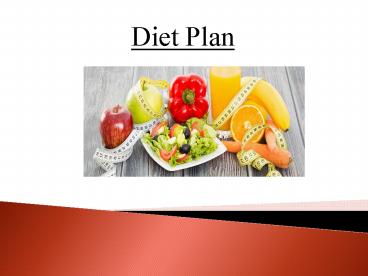What makes up a healthy diet? - PowerPoint PPT Presentation
Title:
What makes up a healthy diet?
Description:
Nutrition and Yoga. Supporting the physical and energetic body through yoga, combined with a balanced diet centered on whole foods and living in harmony nature as the keys to health. – PowerPoint PPT presentation
Number of Views:80
Title: What makes up a healthy diet?
1
- Diet Plan
2
- What makes up a healthy diet?
3
- Intake of saturated fat to less than 10 of total
fat intake (preferably in lean meat and low-fat
dairy products) - Replace saturated fat with polyunsaturated fat
where possible. - Eat at least five portions of fruit and
vegetables per day (new research has suggested
that we should all aim for seven portions per
day). - Eat at least two servings of fish (preferably
oily fish) per week. - Consider regularly eating whole grains and nuts.
- Keep the amount of salt in your dietto less than
6 g per day. - Limit alcohol intake to less than 21 units per
week for men and less than 14 units per week for
women. See also separate leaflet called Alcohol
and Sensible Drinking . Make you proper Diet
Plan.
4
- Avoid or reduce the following in your Diet Plan
- Processed meats or commercially produced foods
(including 'ready meals') which tend to be high
in salt and trans fatty acids. - Refined carbohydrates, such as white bread and
processed cereals. - Sugar-sweetened drinks.
- High-calorie but nutritionally poor snacks, such
as sweets, cakes and crisps. - Below, the principles of a healthy diet are
explained. It is general advice for most people.
If you have a specific health problem, or
specific dietary requirements, this advice may
not apply to you. If in doubt, you should check
with your doctor. There are also some changes
that pregnant women need to make to their
diet. See separate leaflet called Planning to
Become Pregnant for more details.
5
- Carbohydrates
- Much of the energy (calories) in what we eat
comes from carbohydrate. These are divided into
two carbohydrate types - Complex carbohydrates - generally starchy foods
such as bread, pasta, rice and potatoes. - Simple carbohydrates - the sweet sugary foods.
- There is a lot being written about how much of
our food should be made up of carbohydrates but
most of the guidelines recommend about one third.
This should be mostly starchy carbohydrates,
preferably higher-fibre options such as wholemeal
bread, wholegrain cereals and brown rice.
6
- Eat plenty of fruit and vegetables
- New research suggests that eating at least seven
portions of fruit and vegetables daily reduces
the risks of many illnesses, such as stroke,
heart disease and some cancers. Ideally there
should be more vegetables than fruit in your
diet. In addition to these benefits, fruit and
vegetables. - Contain plenty of vitamins and minerals, which
are needed to keep you healthy. - Are naturally low in fat.
- Help to make you feel full after a meal but are
low in calories. - An average portion of vegetables may be about a
handful, or about 80 g. Alternatively, one
portion of fruit or vegetables is roughly
equivalent to one of the following
7
- One large fruit such as an apple, pear, banana,
orange, or a large slice of melon or pineapple. - Two smaller fruits such as plums, kiwis,
satsumas, clementines, etc. - One cup (or a handful) of small fruits such as
grapes, strawberries, raspberries, cherries, etc. - Two large tablespoons of fruit salad, stewed or
canned fruit in natural juices. - One tablespoon of dried fruit.
- One glass of fresh fruit juice (150 ml).
- About three heaped tablespoons of any vegetable.
- One dessert bowl of salad.
8
- Eat plenty of fibre
- Starchy foods and fruit and vegetables
contain the most fibre. So the tips above on
starchy foods and fruit and vegetables will also
increase fibre. If you switch to wholemeal rice
and pasta, and wholemeal bread, this can
significantly increase your fibre intake. Pulses
like lentils and beans are also full of fibre. - Eat enough milk and dairy foods
- Milk and other dairy foods such as cheese and
yoghurt are important in your diet, as they
provide calcium which is needed for healthy teeth
and bones. They are also a source of protein and
can provide other vitamins and minerals important
for your health. Calcium-enriched soya milk and
fromage frais also come under 'milk and dairy
foods'. However, other foods such as butter and
cream are not considered as dairy foods here, as
they are also high in fat, so they come under the
fatty foods group.
9
Follow us on
https//www.facebook.com/LiveBeingFit/
https//www.instagram.com/livebeingfit/
https//twitter.com/livebeingfit
www.pinterest.com/LiveBeingFit/
10
Click to know more on http//www.livebeingfit.com
/our-approach-nutrition/
Thank You































